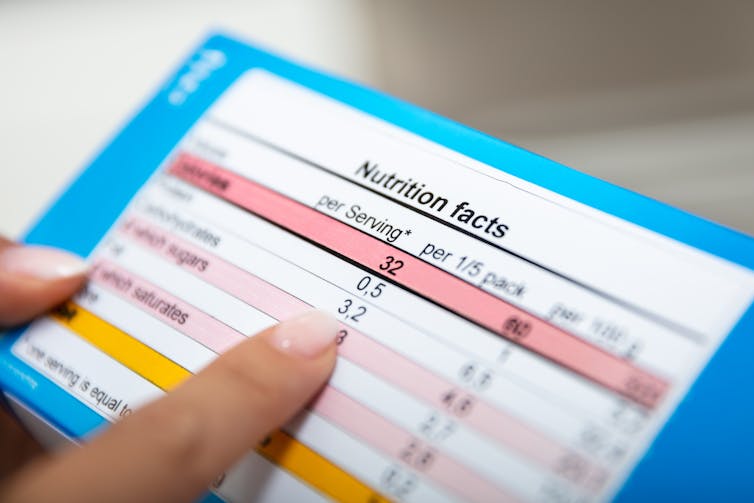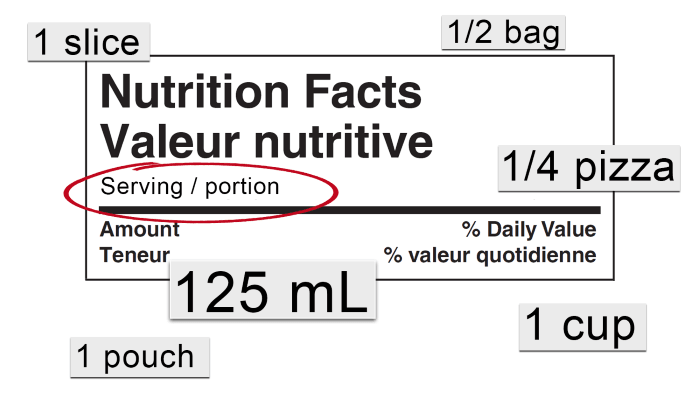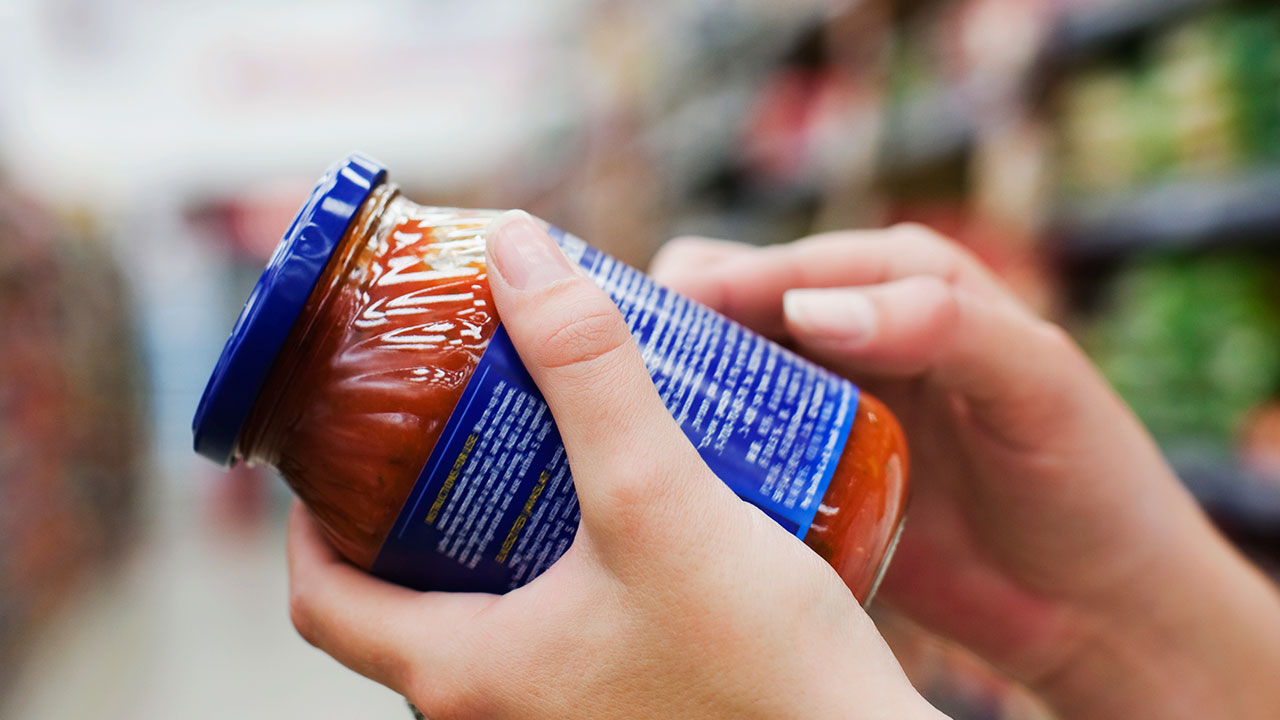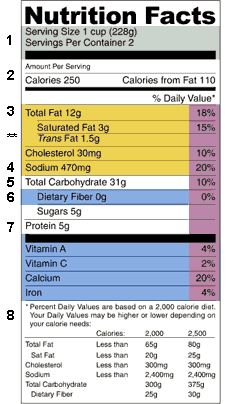38 food labels serving size
Portion Size Versus Serving Size | American Heart Association Serving Size is the amount of food listed on a product's Nutrition Facts label. So all of the nutritional values you see on the label are for the serving size the manufacturer suggests on the package. Once we understand the difference, it's easier to determine how much to serve and easier to teach kids the difference between the two. Learn How the Nutrition Facts Label Can Help You Improve ... Limit the serving size of the treats. If you are going to have dessert, keep it small. Take the Portion Distortion Quiz external icon and learn how food portion sizes have changed in 20 years. Be sure you know how many servings are in food. For example, if you buy what looks like an individual sized chicken pie, check the Nutrition Facts label.
Understanding Serving Size Values on Food Labels - Nina ... The "serving size" of a packaged product is always shown at the very top of the Nutrition Facts label. This is essentially the amount of food recommended to account for one serving. Serving sizes are typically listed in pieces, grams, ounces, tablespoons, cups or other common units of measurement. For instance, a serving of baby carrots ...
Food labels serving size
How to Understand and Use the Nutrition Facts Label | FDA Pay attention to the serving size, especially how many servings there are in the food package. For example, you might ask yourself if you are consuming ½ serving, 1 serving, or more. In the sample... My Food Label: Determining the Serving Size - ReciPal Thus, our serving size should be listed as "1 cookie (40 grams)" or "1 piece (40 grams)". If our average cookie is 60 grams, we show it as "1/2 cookie (30 grams)". And if an average cookie is 10 grams, we list it as "3 cookies (30 grams)". Gaming the Rules A lot of companies game the system and actually use the FDA guidelines to their advantage. Food Serving Sizes Have a Reality Check | FDA In some cases, the reference amounts used to set serving sizes are smaller. Today's individually packaged yogurts more often come in 6-ounce containers, versus the previous 8-ounce ones. The FDA is...
Food labels serving size. Serving size on food label - HealthyLife | WeRIndia Serving size is not a recommendation of how much we drink or eat. It tells us one serving means so much grams and convert it to calories. One package might contain more than one serving; Some packages might have two labels - one for calories and nutrients and the other column listing all information about the food package. Understanding Food Nutrition Labels | American Heart ... The U.S. Food and Drug Administration (FDA) regulates the Nutrition Facts label seen on packaged foods and drinks. In 2016, the FDA released changes to the label to make it easier to see how many calories and added sugars are in a product and to make serving sizes more realistic. Are You Being Tricked By Food Label Serving Sizes? But the calorie count refers to a one-ounce serving, and the label says the bag holds one-and-one-third servings. That appears to conflict with F.D.A. rules that require packages of that type to be labeled as a single serving. Doing the math, the full bag would appear to contain around 130 calories. Serving Size and Nutrition Labelling: Implications for ... - NCBI Declared Serving Size on Packaged Foods A study conducted in Australia analysed 1070 packaged food labels at a Melbourne supermarket and found that among ready-to-eat products, serving sizes varied from 18 to 100 g, precluding a comparison of nutritional values between products [ 36 ].
The Sneaky Truth About Nutrition Labels And Serving Sizes A new study from Cornell's Food and Brand Lab discovered that smaller recommended serving sizes on nutrition labels can lead people to buy more food than they need. The researchers analyzed millions of food purchases in European food markets both before and after the introduction of front-facing nutrition labels. A total of 61 products were ... Serving Size - LabelCalc LabelCalc's nutrition labels adhere to the new serving size, single-serving, and dual-column labeling requirements. LabelCalc is an industry-leading recipe analysis tool used by food manufactures, global retail stores and food entrepreneurs. To get started, see our pricing today. How to Determine Serving Size - LabelCalc Determining the serving size of a food product, on the other hand, is a lot less fun (and certainly less satiating) for food manufacturers. The measuring, the math, and the many FDA guidelines with respect to serving size can all be a little overwhelming. Food Labeling SECG on Serving Size of Foods - US Food and ... A serving size is the amount of food customarily consumed (i.e., typically eaten) in one sitting for that food (section 403(q)(1)(A)(i) of the FD&C Act). Serving sizes are determined from the RACCs...
Serving Sizes and Other Food Label Secrets - Diabetes Self ... The serving size is usually the first thing listed. It should tell you two things: what the size is of one serving, and how many servings are in the container. This is really useful when it comes to figuring out how much to eat. Hieronymus and Carlisle give these sample food labels for packaged pizzas. The Basics of the Nutrition Facts Label Mar 4, 2022 — Compare your portion size (the amount you actually eat) to the serving size listed on the panel. The Nutrition Facts applies to the serving size ... Food Labels | CDC Apr 23, 2021 · Check the Serving size first. All the numbers on this label are for a 2/3-cup serving. This package has 8 servings. If you eat the whole thing, you are eating 8 times the amount of calories, carbs, fat, etc., shown on the label. Total Carbohydrate shows you types of carbs in the food, including sugar and fiber. Understanding food labels - Canada.ca Food labels, nutrition facts tables, serving size, ingredients, % daily value, nutrition claims.
PDF Activity: Food Labels and Serving Sizes 3. Read aloud the directions at the top of the Food Labels and Serving Sizes handout and instruct participants to fill out the front page of the handout based on the amount of food they would each normally eat versus the recommended serving size. 4. Using the copies of Nutrition Facts labels of various foods, have participants fill in the
How To Read Food and Beverage Labels | National Institute ... At the top of the Nutrition Facts label, you will find the total number of servings in the container and the food or beverage's serving size. The serving size on the label is based on the amount of food that people may typically eat at one time and is not a recommendation of how much to eat. Read more about serving and portion sizes.
Serving Size vs Portion Size Is There a Difference Measures about 1 cup An appropriate portion size for raw or cooked vegetables, whole fruit or 100% fruit juice A tennis ball or small, scooped handful Measures about ½ cup Equal to 1-ounce equivalent for grains, such as pasta, rice and oatmeal A deck of cards or the palm of the hand Measures about 3 ounce-equivalents

No, serving sizes on food labels don't tell us how much we should eat - Eating Well at Flinders
Serving Size Updates on the New Nutrition Facts Label Feb 25, 2022 · On the original Nutrition Facts label, the serving size was 1/2 cup (66g), while on the new Nutrition Facts label, the serving size is 2/3 cup (88g). While it may look like the calories and...
Serving Size for Food Products - LabelCalc The label statement refers to what needs to be stated on the nutrition label. In the case of our biscuit example, a single serving of biscuit should weigh approximately 55g, however, on the nutrition label itself you may also refer to the single serving as "piece" or even "biscuit". (If your individual biscuit size is going to exceed ...
Food Labels and Serving Size - DTN Progressive Farmer The concept of "one serving size fits all" seems unrealistic. Perhaps benchmarks of 100, 200, 300 calories and so forth should be presented. This is not the first flap over labeling that has...
Serving Sizes In The Food Guide Pyramid And On Food Labels In comparison, the serving sizes on the food label are standardized to help you compare similar products. The Food and Drug Administration (FDA) based these reference serving sizes on the amount of the food item typically eaten in one sitting, derived from nationwide food consumption surveys of Americans. Years ago, the serving size on the food ...
Why Are Serving Sizes on Nutrition Labels So Small? R. F. of Anna, Tex., writes: The serving sizes on the nutrition labels for some foods are unrealistically small, especially for foods high in fat, sugar, or sodium.
Serving size - Canada.ca Serving size is listed in a common household measure. It also is listed in grams or millilitres depending on the type of food. Common household measures include: a fraction of a food such as 1/4 pizza (90 g) number of pieces such as 4 crackers (20 g) cups, teaspoons or tablespoons (3/4 cup of yogurt [175 g] or 1 tablespoon of peanut butter [15 g] )
Nutrition Labels: Who Determines What a Serving Size Is? Ice cream nutrition labels have been modified accordingly, with a pint of Ben & Jerry's now defined as three servings instead of four. Soda, meanwhile, has increasingly been sold in larger containers — from a 12-ounce can to 20-ounce bottles. Nutrition labels now better reflect those increases, too.
Serving Size on the New Nutrition Facts Label | FDA Feb 25, 2022 · First, look at the serving size and the number of servings per container, which are at the top of the label. The serving size is shown as a common household measure that is appropriate to the food...
Understanding the FDA Food Label The Serving Size The serving size is located at the top of the FDA food label. It not only tells you the amount of a single serving, but it will tell you how many servings are in the container. For example, the label on a can of pears may note that the serving size is ½ cup and that the can contains three servings. Serving Size vs. Portion Size
Food Serving Sizes Have a Reality Check | FDA In some cases, the reference amounts used to set serving sizes are smaller. Today's individually packaged yogurts more often come in 6-ounce containers, versus the previous 8-ounce ones. The FDA is...
My Food Label: Determining the Serving Size - ReciPal Thus, our serving size should be listed as "1 cookie (40 grams)" or "1 piece (40 grams)". If our average cookie is 60 grams, we show it as "1/2 cookie (30 grams)". And if an average cookie is 10 grams, we list it as "3 cookies (30 grams)". Gaming the Rules A lot of companies game the system and actually use the FDA guidelines to their advantage.
How to Understand and Use the Nutrition Facts Label | FDA Pay attention to the serving size, especially how many servings there are in the food package. For example, you might ask yourself if you are consuming ½ serving, 1 serving, or more. In the sample...







Post a Comment for "38 food labels serving size"